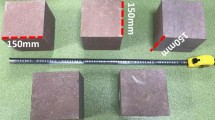Summary
A conceptual model for the behaviour of rock joints during cyclic shear and under constant normal stresses was proposed according to results from shear tests with 50 concrete replicas of rock joints. The shear strength and deformability of joint samples were found to be both anisotropic and stress dependent. Based on these experimental results, a two-dimensional constitutive model was developed for rock joints undergoing monotonic or cyclic loading sequences. The joint model was formulated in the framework of non-associated plasticity, coupled with empirical relations representing the surface roughness degradation, appearance of peak and residual shear stresses, different rates of dilatancy and contraction, variable normal stiffness with normal deformation, and dependence of shear strength and deformability on the normal stress. The second law of thermodynamics was represented by an inequality and used to restrict the values of some of the material parameters in the joint model. The new joint model was implemented into a two-dimensional Distinct Element Method Code, UDEC, and its predictions agreed well with some well-known test results.
Similar content being viewed by others
References
Amadei, B., Saeb, S. (1990): Constitutive models of rock joints. In: Rock joints, Proc. Int. Symp. on Rock Joints, Loen, Norway, 581–594.
Bandis, S. C., Lumsden, A. C., Barton, N. R. (1983): Fundamentals of rock joint deformation. Int. J. Rock Mech. Min. Sci. Geomech. Abstr. 20, 249–268.
Barton, N. (1976). Rock mechanics review: the shear strength of rock and rock joints. Int. J. Rock Mech. Min. Sci. Geomech. Abstr. 13, 255–279.
Barton, N., Bandis, S., Bakhtar, K. (1985): Strength, deformation and conductivity coupling of rock joints. Int. J. Rock Mech. Min. Sci. Geomech. Abstr. 22, 121–140.
Cundall, P. A. (1980): UDEC — A generalized distinct element program for modelling jointed rock. Final technical report to European Research Office, U. S. Army, Contract DAJA37-79-0548.
Goodman, R. E. (1976). Methods of geological engineering in discontinuous rocks. West Publishing Company, San Francisco.
Hutson, R. W. (1987). Preparation of duplicate rock joints and their changing dilatancy under cyclic shear. Ph. D. Thesis, Northwestern University, Evanston, Illinois.
Jing, L. (1990): Numerical modelling of jointed rock masses by Distinct Element Method for two and three-dimensional problems. Ph. D. Thesis, Luleå University of Technology, Luleå, Sweden.
Kutter, H. K., Weissbach, G. (1980): Der Einfluß von Verformungs-und Belastungsgeschichte auf den Scherwiderstand von Gesteinsklüften unter besonderer Berücksichtigung der Mylonitbildung. Final Report. DFG Research Project, Ku361/2/4.
Martin, J. B. (1975). Plasticity. MIT Press, Cambridge, Mass.
Plesha, M. E. (1987). Constitutive models for rock discontinuities with dilatancy and surface degradation. Int. J. Numer. Anal. Methods Geomech. 11, 345–362.
Author information
Authors and Affiliations
Rights and permissions
About this article
Cite this article
Jing, L., Stephansson, O. & Nordlund, E. Study of rock joints under cyclic loading conditions. Rock Mech Rock Engng 26, 215–232 (1993). https://doi.org/10.1007/BF01040116
Issue Date:
DOI: https://doi.org/10.1007/BF01040116




